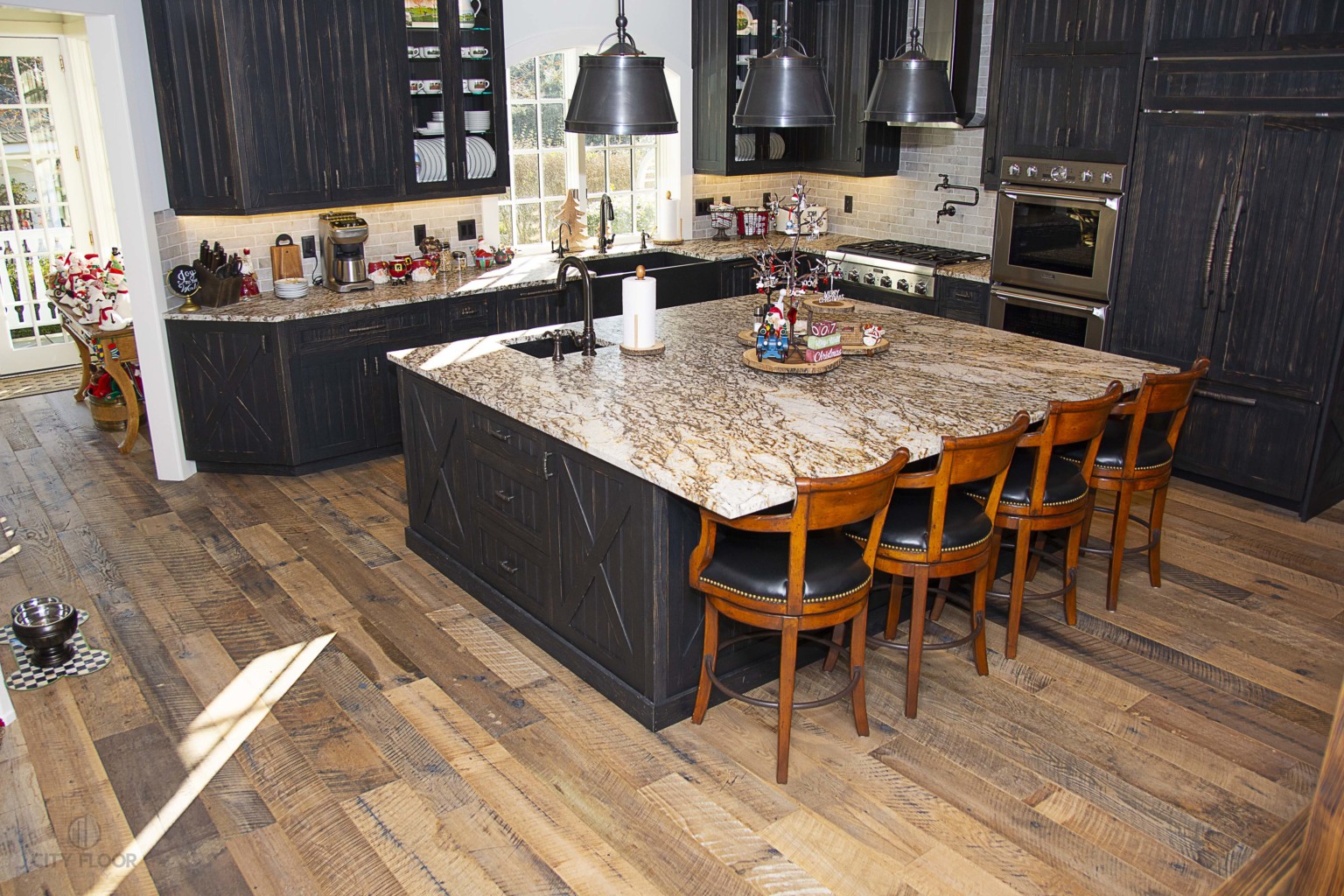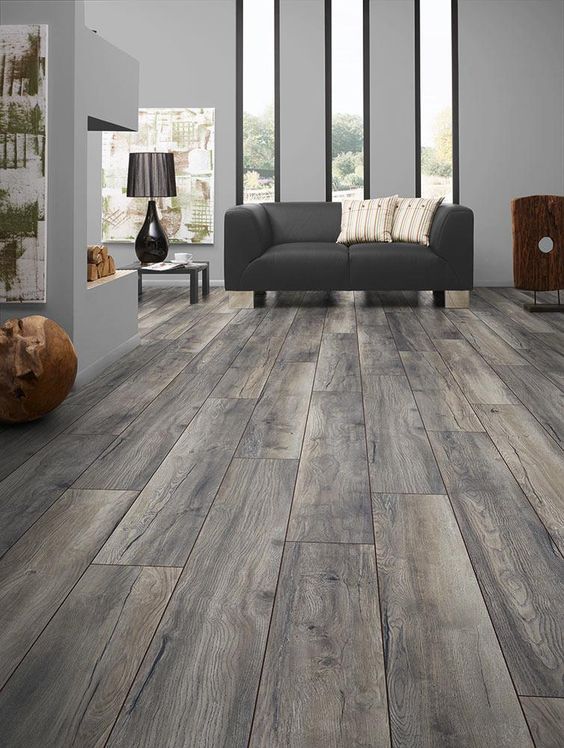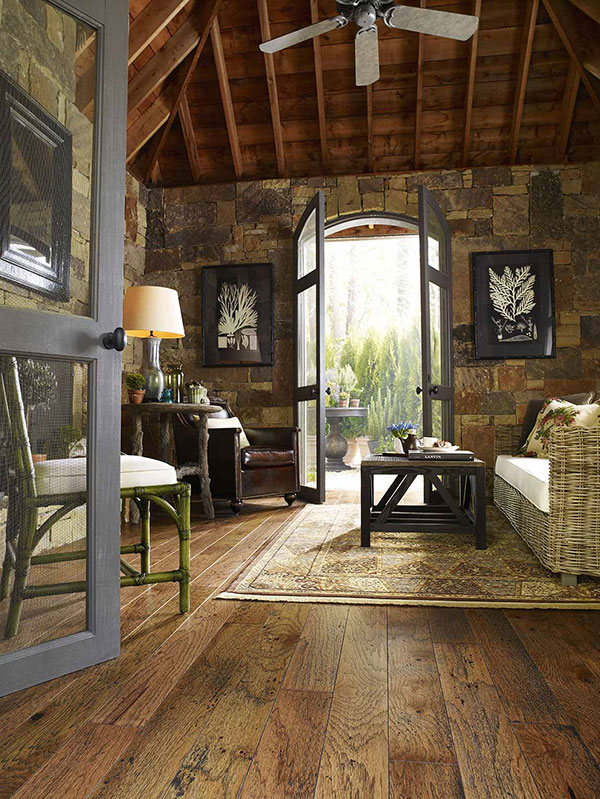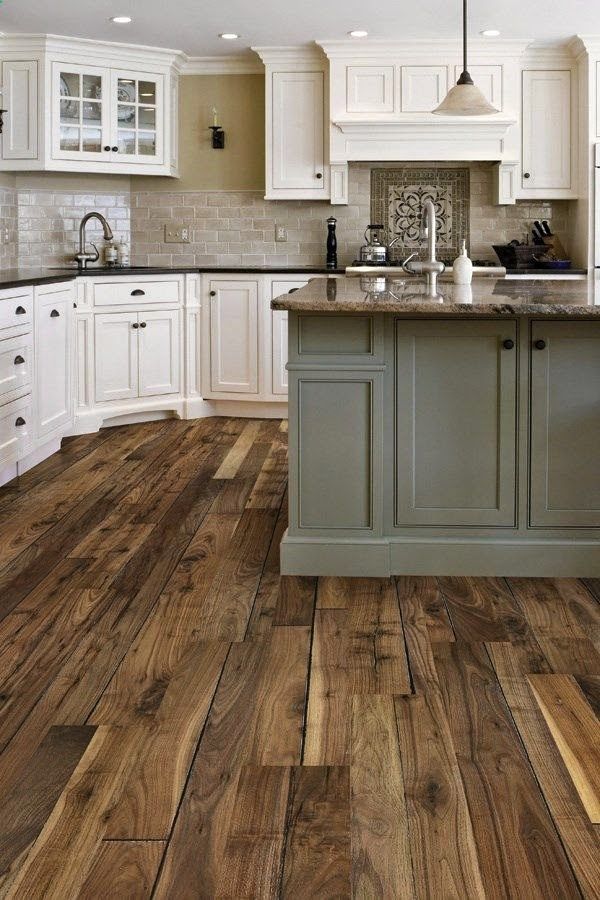Choosing the Right Wood Species for Rustic Hardwood Floors
The first step in achieving a rustic hardwood look is selecting the right wood species. Each type of wood has unique characteristics, including color, grain pattern, and hardness, that can significantly impact the overall aesthetic.
- Oak Flooring: Oak is one of the most popular choices for rustic hardwood flooring due to its durability and wide range of available colors. White oak, with its muted, grayish tones, provides a more understated, refined rustic look, while red oak offers warmer, reddish hues that add richness and depth to the floor. Both types of oak have prominent grain patterns that enhance the rustic appeal.
- Hickory Flooring: Hickory is known for its dramatic grain patterns and color variations, making it an excellent choice for those looking to make a bold statement. The natural contrast between light and dark areas in hickory wood creates a striking, eye-catching floor that embodies rustic charm. Hickory’s hardness also makes it an incredibly durable option, perfect for high-traffic areas.
- Pine Flooring: For a softer, more traditional rustic look, pine is an ideal choice. Pine floors tend to have more knots and natural imperfections, which contribute to the rustic aesthetic. Over time, pine flooring develops a beautiful patina, adding character and history to the space. However, pine is softer than oak or hickory, making it more prone to dents and scratches.
- Walnut Flooring: Walnut offers a luxurious take on rustic flooring. Its rich, dark brown tones and fine, straight-grain patterns provide a more elegant, refined rustic look. While walnut is slightly softer than oak, it still offers good durability and is an excellent choice for spaces where a more sophisticated rustic feel is desired.
- Reclaimed Wood Flooring: Reclaimed wood, sourced from old barns, factories, or other structures, is the ultimate rustic flooring option. Each plank of reclaimed wood has a unique history, with visible nail holes, weathering, and other imperfections that tell a story. Reclaimed wood floors are not only environmentally friendly but also add unparalleled character to any space.
- Mixed Species Flooring: For a truly unique rustic look, consider using a mix of wood species. Combining different woods can create a floor with varying colors and textures, adding depth and interest to the room. This approach works particularly well in large, open spaces where the floor becomes a focal point.

Finishing Techniques for Enhancing Rustic Hardwood Floors
The finish you choose for your hardwood floor can significantly alter its appearance and enhance its rustic charm. Various finishing techniques can bring out the natural beauty of the wood while adding durability and protection.
Hand-Scraped Finishes: Hand-scraped hardwood floors have a textured, worn-in look that adds a sense of age and character. This technique involves manually scraping the wood surface, creating grooves and ridges that mimic the appearance of old, well-worn floors. Hand-scraped finishes are ideal for those looking to achieve a truly authentic rustic aesthetic.
Wire-Brushed Finishes: Wire brushing is another popular technique for rustic hardwood flooring. This process involves running a wire brush over the wood surface to remove the softer grains, leaving behind a textured, weathered look. Wire-brushed finishes enhance the wood’s natural grain and are particularly effective at hiding scratches and dents, making them a practical choice for busy households.
Distressed Finishes: Distressed finishes give hardwood floors an aged, antique appearance. This technique can include a combination of hand-scraping, wire-brushing, and other methods to create a floor that looks as though it has been well-used and well-loved over time. Distressed finishes are perfect for achieving a rustic look with a sense of history and personality.
Matte and Low-Sheen Finishes: For a more understated rustic look, consider opting for a matte or low-sheen finish. These finishes don’t reflect as much light as high-gloss finishes, giving the floor a more natural, lived-in appearance. Matte finishes are also excellent for hiding imperfections, making them a great choice for rustic floors that are meant to be practical as well as beautiful.
Oil-Based Finishes: Oil-based finishes penetrate the wood, bringing out its natural colors and enhancing its grain patterns. These finishes tend to give the wood a warmer, richer tone, which is ideal for rustic floors. Oil finishes also allow the wood to breathe, developing a patina over time that adds to the rustic appeal.
Natural and Stain-Free Finishes: For a truly authentic rustic look, consider leaving the wood as natural as possible. A clear, stain-free finish allows the wood’s natural color and texture to shine through, creating a floor that is both simple and striking. This approach works particularly well with wood species that have strong, distinctive grain patterns, such as oak or hickory.
Incorporating Rustic Hardwood Flooring in Different Rooms
Rustic hardwood flooring can be used throughout the home, but the way it’s incorporated can vary depending on the room’s function and style. Each space offers unique opportunities to highlight the floor’s natural beauty and create a cohesive, rustic look.
Rustic Hardwood Flooring in the Living Room: The living room is often the heart of the home, making it an ideal space for showcasing rustic hardwood floors. A wide-plank, hand-scraped oak or hickory floor can serve as a stunning foundation for a cozy, inviting living room. Pairing the floor with a stone fireplace, exposed beams, and comfortable, overstuffed furniture will enhance the rustic feel and create a warm, welcoming environment.
Rustic Hardwood Flooring in the Kitchen: In the kitchen, rustic hardwood floors can add warmth and character to a space that is often dominated by hard surfaces like countertops and appliances. A distressed or wire-brushed finish is particularly well-suited to the kitchen, as it can hide scratches and wear from heavy foot traffic. Pair the floor with rustic cabinetry, open shelving, and farmhouse-style fixtures for a cohesive, country-inspired kitchen.
Rustic Hardwood Flooring in the Bedroom: A bedroom with rustic hardwood flooring can be both tranquil and charming. Soft, warm wood tones create a calming atmosphere, perfect for a space dedicated to relaxation. Consider using reclaimed wood for a bedroom floor, as its unique imperfections and weathered look can add a sense of history and personality to the room. Complement the floor with neutral bedding, cozy textiles, and vintage-inspired decor for a serene, rustic retreat.
Rustic Hardwood Flooring in the Bathroom: While hardwood flooring isn’t traditionally used in bathrooms due to moisture concerns, it can be a beautiful and practical choice when properly sealed and maintained. A rustic hardwood floor in the bathroom can add warmth and texture to a space that often feels cold and sterile. Consider pairing the floor with a clawfoot tub, antique fixtures, and natural stone accents for a spa-like, rustic bathroom.
Rustic Hardwood Flooring in the Dining Room: The dining room is another excellent space for rustic hardwood flooring. A rich, dark walnut or hickory floor can create a dramatic backdrop for family meals and gatherings. Pair the floor with a large, farmhouse-style dining table, mismatched chairs, and vintage lighting fixtures for a rustic, yet elegant dining room. Adding a large area rug under the table can also help define the space and protect the floor from spills and scratches.
Rustic Hardwood Flooring in the Home Office: A home office with rustic hardwood flooring can be both inspiring and functional. The natural beauty of the wood can create a calming, focused environment, while the rustic aesthetic can add a touch of warmth and personality to the space. Consider using a wide-plank, matte-finished oak floor for the office, paired with simple, rustic furniture and plenty of natural light to create a productive and aesthetically pleasing workspace.
Color Schemes and Design Ideas to Complement Rustic Hardwood Floors
The color scheme and overall design of your space play a crucial role in highlighting the beauty of rustic hardwood floors. By carefully selecting colors and design elements, you can create a cohesive look that enhances the rustic charm of your flooring.
Neutral and Earthy Tones: Neutral and earthy tones are the perfect complement to rustic hardwood floors. Colors like beige, taupe, gray, and brown create a warm, inviting backdrop that allows the natural beauty of the wood to shine. These tones work particularly well in living rooms, bedrooms, and kitchens, where a cozy, welcoming atmosphere is desired. Consider using different shades of these colors on the walls, furniture, and decor to add depth and interest to the space.
Contrasting Colors: For a more dynamic look, consider using contrasting colors to highlight the rustic hardwood floor. Dark wood floors, such as walnut or hickory, can be beautifully offset by light, airy walls in shades of white, cream, or light gray. Conversely, light wood floors, such as pine or white oak, can be contrasted with darker walls or furniture to create a striking, dramatic effect. This approach works particularly well in modern rustic or industrial-inspired spaces.
Incorporating Natural Materials: Natural materials like stone, metal, and leather are excellent companions to rustic hardwood floors. These materials add texture and interest to the space, enhancing the natural, organic feel of the floor. For example, a stone fireplace or metal light fixtures can add a rugged, earthy element to a room with rustic hardwood flooring. Leather furniture or accents can also contribute to the warm, inviting atmosphere of the space.
Layering Textiles: Layering textiles is a great way to add softness and comfort to a space with rustic hardwood floors. Rugs, curtains, throw blankets, and pillows in natural fabrics like wool, linen, or cotton can create a cozy, lived-in feel. Choose textiles in complementary colors and patterns to enhance the rustic aesthetic. For example, a large, neutral-toned area rug can anchor a living room, while plaid or striped throw pillows can add a touch of rustic charm.
Using Vintage and Antique Pieces: Vintage and antique furniture and decor are perfect for enhancing the rustic feel of hardwood floors. These pieces often have a sense of history and character that complements the natural beauty of the wood. Consider incorporating vintage dressers, side tables, or lighting fixtures into your space. Antique rugs, artwork, or mirrors can also add a touch of elegance and nostalgia to a room with rustic hardwood flooring.
Minimalist Approach: A minimalist approach can also work well with rustic hardwood floors, allowing the natural beauty of the wood to take center stage. Keep furniture and decor simple and understated, focusing on quality over quantity. Choose pieces with clean lines and natural materials that complement the rustic floor without overwhelming it. This approach is particularly effective in modern rustic or Scandinavian-inspired spaces.
Maintaining and Caring Tips
Proper maintenance is key to preserving the beauty and longevity of rustic hardwood floors. While these floors are designed to embrace imperfections and wear, regular care is still necessary to keep them looking their best.
Regular Cleaning: Regular cleaning is essential for maintaining rustic hardwood floors. Dust, dirt, and debris can scratch the surface if not removed promptly. Sweep or vacuum the floors regularly using a soft-bristle broom or a vacuum with a hardwood floor attachment. Avoid using a vacuum with a beater bar, as it can damage the wood. Damp mopping with a hardwood floor cleaner is also recommended, but be sure to avoid excessive water, as moisture can cause the wood to warp or swell.
Protecting Against Scratches and Dents: While rustic hardwood floors are designed to embrace a certain level of wear and tear, it’s still important to protect them from unnecessary damage. Use felt pads under furniture legs to prevent scratches and dents. Place rugs or mats in high-traffic areas, such as entryways and hallways, to protect the floor from dirt and debris. Encourage family members and guests to remove their shoes before walking on the floor to reduce the risk of scratches.
Dealing with Spills and Stains: Spills should be cleaned up immediately to prevent staining or water damage. Use a soft, dry cloth to blot the spill, then clean the area with a damp cloth and hardwood floor cleaner if necessary. Avoid using harsh chemicals or abrasive cleaners, as they can damage the finish. For tough stains, consider using a wood-specific stain remover or consulting a professional.
Refinishing and Repairing: Over time, rustic hardwood floors may develop deeper scratches, dents, or wear patterns that require refinishing. Refinishing involves sanding down the top layer of the wood and applying a new finish to restore its appearance. This process can also be an opportunity to change the floor’s finish or stain color if desired. Small scratches or dents can often be repaired with wood filler or a touch-up pen. For more significant damage, consider consulting a professional.
Humidity and Temperature Control: Wood is a natural material that can expand and contract with changes in humidity and temperature. To prevent warping or cracking, it’s important to maintain consistent indoor humidity levels, ideally between 35% and 55%. Using a humidifier in the winter and a dehumidifier in the summer can help achieve this balance. Avoid exposing the floor to direct sunlight for extended periods, as UV rays can cause the wood to fade or discolor over time.
Professional Maintenance: While regular cleaning and care can go a long way in maintaining rustic hardwood floors, professional maintenance may be necessary for deep cleaning or restoration. Consider scheduling a professional cleaning once a year to remove built-up dirt and grime that regular cleaning may miss. If the floor shows signs of significant wear or damage, a professional can assess the situation and recommend the best course of action, whether it’s refinishing, repair, or replacement.
Incorporating Rustic Hardwood Floors into Various Interior Design Styles
Rustic hardwood floors are incredibly versatile and can be incorporated into a wide range of interior design styles. Whether your taste leans toward traditional, modern, or eclectic, rustic hardwood flooring can serve as a beautiful foundation for your design vision.
Farmhouse Style: Rustic hardwood floors are a natural fit for farmhouse-style interiors. The warm, natural tones of the wood complement the cozy, inviting aesthetic of farmhouse decor. Wide-plank, distressed oak or pine floors work particularly well in this style, adding a sense of history and character to the space. Pair the floors with shiplap walls, vintage furniture, and neutral textiles for a classic farmhouse look.
Modern Rustic Style: Modern rustic design combines the warmth and charm of rustic elements with the clean lines and simplicity of modern design. In this style, rustic hardwood floors serve as a grounding element, providing warmth and texture to a space that might otherwise feel cold or sterile. Choose floors with a matte or low-sheen finish to enhance the modern feel, and pair them with minimalist furniture, neutral color palettes, and natural materials like stone or metal.
Industrial Style: Industrial design is characterized by its use of raw, unfinished materials and a utilitarian aesthetic. Rustic hardwood floors can add warmth and contrast to the cool, edgy feel of industrial interiors. Consider using reclaimed wood or distressed finishes to enhance the industrial vibe. Pair the floors with exposed brick walls, metal fixtures, and leather furniture for a cohesive, industrial-inspired space.
Traditional Style: In traditional interiors, rustic hardwood floors can add a touch of warmth and character to a more formal, refined space. Dark wood floors, such as walnut or mahogany, work particularly well in traditional settings, adding richness and depth. Pair the floors with classic furniture, rich fabrics, and ornate details for a timeless, elegant look. Area rugs can also be used to define spaces and add softness to the room.
Bohemian Style: Bohemian design is all about creativity, color, and individuality. Rustic hardwood floors provide a beautiful, neutral backdrop for the eclectic mix of patterns, textures, and decor that define this style. Light wood floors, such as pine or white oak, work particularly well in bohemian spaces, allowing the vibrant colors and bold patterns to take center stage. Layer rugs, cushions, and textiles to create a cozy, bohemian retreat.
Scandinavian Style: Scandinavian design is known for its simplicity, functionality, and use of natural materials. Rustic hardwood floors fit seamlessly into this style, adding warmth and texture to the clean, minimalist interiors. Light, wide-plank floors with a matte finish are ideal for Scandinavian spaces, complementing the neutral color palettes and simple, functional furniture. Add touches of greenery and natural light to complete the serene, Scandinavian-inspired look.
Common Mistakes to Avoid
Overlooking the Wood Species: Choosing the wrong wood species can significantly impact the look and durability of your floor. It’s essential to consider the wood’s hardness, color, and grain pattern to ensure it aligns with your design vision and functional needs.
Ignoring the Finish: The finish plays a crucial role in both the appearance and longevity of the floor. Skipping the finish or choosing one that doesn’t suit your lifestyle can lead to premature wear and damage.
Neglecting Regular Maintenance: Rustic hardwood floors require regular care to maintain their beauty. Ignoring cleaning, moisture control, or scratch prevention can lead to lasting damage and diminish the floor’s rustic charm.
Choosing the Wrong Installation Method: The installation method can affect the stability and appearance of the floor. It’s essential to choose the right method based on the type of subfloor and the specific wood species to prevent issues like warping or gaps.
Overloading with Design Elements: While rustic hardwood floors are beautiful, it’s important not to overwhelm the space with too many rustic elements. Balancing the rustic floor with other design styles can create a more cohesive and appealing space.
Underestimating the Importance of Humidity Control: Failing to control indoor humidity can lead to significant problems with hardwood floors, including warping, cracking, and gaps. It’s crucial to maintain consistent humidity levels to protect the floor.
What is the best wood species for rustic hardwood flooring?
The best wood species for rustic hardwood flooring depends on your specific aesthetic and functional needs. Oak and hickory are popular choices for their durability and prominent grain patterns, while pine offers a softer, more traditional rustic look. Reclaimed wood is also an excellent option for achieving an authentic rustic feel with added character.
How do I maintain and care for rustic hardwood floors?
Maintaining rustic hardwood floors involves regular cleaning, protecting against scratches, and managing humidity levels. Sweeping or vacuuming the floors regularly, using felt pads under furniture, and controlling indoor humidity can help preserve the floor’s beauty. Occasional refinishing may be necessary to restore the floor’s appearance as it ages.
Can rustic hardwood floors be used in kitchens and bathrooms?
Yes, rustic hardwood floors can be used in kitchens and bathrooms, but they require proper sealing and maintenance to protect against moisture. In these areas, it’s essential to clean up spills immediately and avoid excessive water exposure. Using a durable, water-resistant finish can also help protect the wood.
What is the difference between solid and engineered rustic hardwood flooring?
Solid rustic hardwood flooring is made from a single piece of wood, offering a traditional look and the ability to be refinished multiple times. Engineered hardwood flooring consists of a top layer of wood veneer over a plywood base, providing better stability in areas with fluctuating humidity. Both options can achieve a rustic look, but the choice depends on your specific needs and the installation environment.
How does rustic hardwood flooring compare to laminate flooring?
Rustic hardwood flooring offers a natural, authentic look with unique grain patterns and textures that can’t be replicated by laminate flooring. While laminate is more affordable and resistant to scratches and moisture, it lacks the character and warmth of real wood. Rustic hardwood floors also have the advantage of being refinished, while laminate must be replaced once it’s worn out.
Is it possible to install rustic hardwood flooring over existing flooring?
Yes, it’s possible to install rustic hardwood flooring over existing flooring, depending on the type of subfloor and the condition of the existing floor. Floating engineered hardwood floors are particularly suitable for this, as they can be installed without the need for nails or glue. However, it’s important to ensure the existing floor is level, dry, and in good condition before installation to avoid any issues.
Amazing Ideas of Rustic Wood Flooring for an Extravagant Look
Latest and Greatest Flooring Trends
Related Posts:









